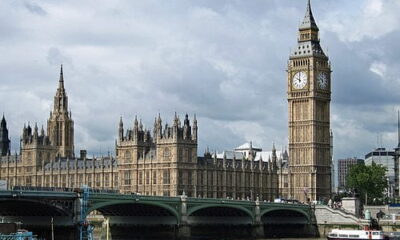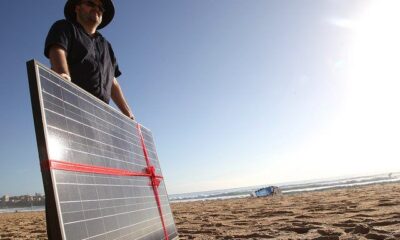

Environment
Samuel Vionnet on Natural Capital
This month, Samuel Vionnet, who support organisations to integrate the value of nature into decision making and has worked with companies such as Ikea, L’Oréal, Nestlé, Nespresso, Pernod Ricard, STMicroelectronics and Unilever, will be speaking at the 2015 World Forum on Natural Capital in Edinburgh. Today he writes for Blue & Green Tomorrow.
Natural Capital – The key to implementing sustainable development
“Following the recent UN summit in New York, the Sustainable Development Goals (SDGs) have regularly topped the news agenda and the topic of sustainability has been hard to miss. The SDGs are composed of a universal set of 17 goals and 169 targets, which member states will be expected to use to frame sustainability policies and agendas.
“Some have called the SDGs a list of priorities, but looking closer at the 169 targets it is crucial that leaders ask themselves what are the actual priorities and what role natural capital plays in achieving these targets?
“Of the targets outlined by the SDGs, 19 relate directly to natural capital, however if wider issues related to natural capital are considered, for example built or financial capital, this number rises to 36. These 36 targets contribute to more than 50% of the overall SDGs targets through more than 180 direct and positive links. By ‘direct’ I mean that a clear impact can be assessed. This could include instances such as UN member states investing in water-related ecosystems which subsequently will contribute to reaching the goal of water access for all.
“More surprisingly, 152 negative links can be identified, some of which can only be achieved at the expense of natural capital. It is worth mentioning here that businesses cannot just pick and choose the targets that work best for their sustainability strategy and move on: systemic thinking is what is required here. To create a positive impact, and avoid unnecessary collateral damage, it is vital that business leaders understand the system dynamic and focus on the targets that will unlock the highest value, both for wider society and for their business.
“Thinking systematically, it becomes clear that some of the targets set out through the SGDs are more connected than others. Using the links identified earlier, it can be observed that sustainable agriculture (target 2.4) and water-related ecosystems (target 6.6) are the two most connected targets. Other targets requiring the sustainable management of forests, land and soil (15.2 and 15.3) are just corollaries.
“The single target able to be connected further to other targets recommends integrating ecosystem and biodiversity values into all management systems and decisions (15.9). It identifies the relevance and importance of the work of the Natural Capital Coalition, which is currently developing a Natural Capital Accounting Protocol for the private sector. This will form the basis of the business case for investing in sustainable development.
“So which targets are benefiting the most from the natural capital targets of the SDGs? These are include those targets relating to access to water (6.1), resilience and adaptation to climate change (13.1) and doubling the agricultural productivity and income of small scale food producers (2.3). For all of these targets there is a direct correlation with natural capital.
“If businesses and UN member states are serious about increasing access to water, they cannot just build water wells: instead they must invest in water-related ecosystems. If they are serious about improving resilience and adaptation to climate change, they must not solely invest in energy efficiency and renewable energy, but invest as well in green infrastructure. If they are serious about helping smallholders to feed the world, then they must begin investing in soil quality and ecosystem-based solutions, such as agro-forestry.
“We know that if we lose natural capital, it is the entire wealth of society, including economic value, which we are losing. In order to develop our economy, we must protect natural capital.
“The engagement of the private sector is crucial. A recent study that reviewed CSR reports from 174 multi-national companies, all of whom were members of the WBCSD, found that less than 40% of companies identified biodiversity, an issue at the core of natural capital, as a material issue. This figure falls to less than 20% for topics such as land use, soil and forests.
Natural capital was only mentioned by nine companies out of the 174 reviewed. Although water has been identified as material by 75% of companies, this figure drops to 20% when we consider supply chain exposition to water related risks, which is the principal issue faced by many sectors.
“It is crucial that we start valuing natural capital – with it we could solve more than half the world’s problems.”
World Forum on Natural Capital
The second World Forum on Natural Capital will take place in Edinburgh on 23-24 November 2015. Bringing together business leaders, government representatives and environmental experts from around the globe, the event will examine the most up-to-date developments in this rapidly evolving field, with a focus on managing risk and driving innovation. More information about natural capital can be found here.


 Environment10 months ago
Environment10 months agoAre Polymer Banknotes: an Eco-Friendly Trend or a Groundswell?

 Environment12 months ago
Environment12 months agoEco-Friendly Home Improvements: Top 7 Upgrades for 2025

 Features9 months ago
Features9 months agoEco-Friendly Cryptocurrencies: Sustainable Investment Choices

 Features10 months ago
Features10 months agoEco-Friendly Crypto Traders Must Find the Right Exchange





























